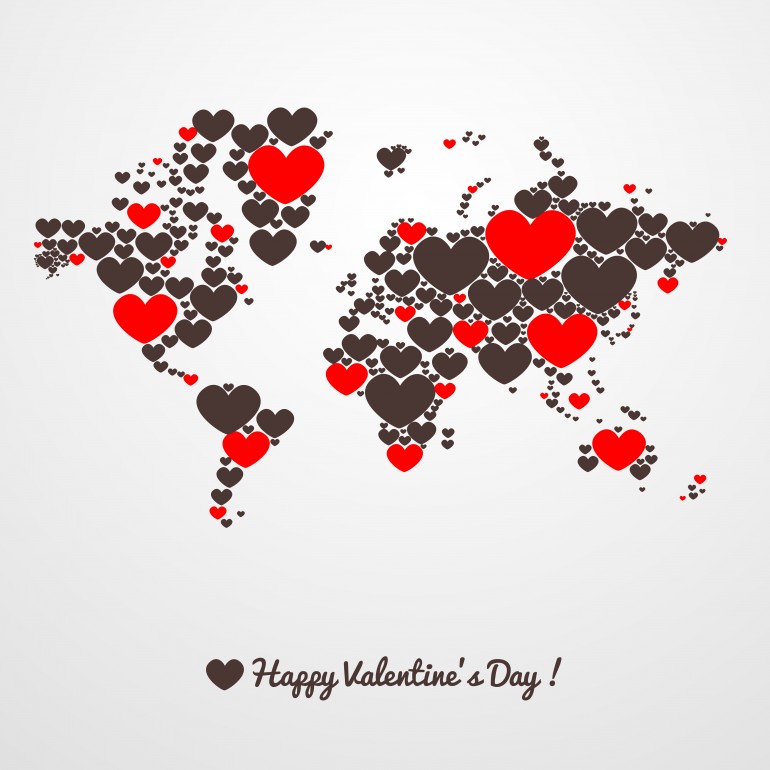Love with no borders: How Valentine’s Day is celebrated around the world
We’re less than a week from the most loving day of the year. Valentine’s Day marks the day of red heart balloons, pink heart patterns, teddy bears, chocolate and flowers. But does the world love the same way? What happens beyond U.S. borders?
According to Alan Taylor for The Atlantic, Valentine’s Day is a traditional western holiday celebrated in many countries around the globe. Vogue France says the celebration began as a pagan festival involving sacrifices to the god of fertility and a matchmaking lottery.
Since then, the celebration has become heavily commercialized. Valentine’s Day fuels a potent American industry that usually spends nearly $16 billion. So, around here, this celebration goes beyond feelings.
Still, just like many other holidays, Valentine’s Day carries its traditions that change worldwide.
Each culture has its way of celebrating love — the world is big, so stay tuned with me. You’ll learn to love in twenty different ways.
Argentina: According to Travel Magazine, besides celebrating Valentine’s Day, Argentinians also set aside an entire week during July to celebrate ‘Sweetness Week,’ when kisses are exchanged for sweet treats. Initially set up as a confectioners’ marketing campaign, the nation quickly embraced it.
Brazil: The day of lovers, Dia dos Namorados, is celebrated on June 12th. According to Travel Magazine, Saint Anthony’s Day, the patron saint of marriage, is celebrated the following Day.
Like Argentina, this tradition started as a commercial initiative that perdured the years. However, the celebration is more about romantic love, and it’s celebrated over dinners and gifts.
Bulgaria: On Feb. 14, Bulgarians celebrate St. Trifon Zarezan Day — otherwise known as Winemakers Day. According to Vogue France, traditionally, people would go to the vineyards to participate in a ritual before crowning the best winemaker present. Nowadays, people still join in St Trifon parades and celebrate Valentine’s Day over a bottle of wine.
China: In China, Valentine’s Day is celebrated during the Qixi Festival. The Chinese festival of love takes place on the 7th Day of the 7th month on the Chinese calendar.
According to Travel Magazine, this celebration originated from the tragic tale of two star-crossed lovers forced apart due to their social status, yet allowed to reunite once a year. These days, singletons prepare fruit in the hopes for future love, while couples pray for prosperity.
CNN reports that this holiday is a popular day to get married in China. Another trend in China, a practice started in Taiwan, is to have pre-wedding photoshoots.
During the Sister’s Meal Festival in South West China, women cook an assortment of colorful rice dishes offered to suitors, according to Travel Magazine. The fate of the relationship depends on the item found within the rice — two chopsticks mean love, but a clove of garlic means the romance is over before it even begins.
Czech Republic: Although Valentine’s Day has become more prevalent recently, it is May 1 when Czech lovers traditionally celebrate. According to Travel Magazine, many couples pilgrimage to the statue of poet Karel Hynek Mácha in Petrin Park, while a kiss beneath the cherry blossom is meant to bring good luck for the coming year.
Denmark: While cards are sent worldwide on Valentine’s Day, the Danes take tradition dating back to the 18th century. According to Vogue France, secret admirers will send gaekkebrev (joking letters) to their crushes, generally in the form of a paper snowflake featuring a poem. The sender signs their name in dots and has to give the recipient an Easter egg if they manage to guess their identity.
Estonia and Finland: On Feb. 14, friendship, rather than romantic love, is celebrated during Sobrapaev, literally translated as ‘Friendship Day.’ According to Travel Magazine, the same happens in Finland, where the celebration is knowns as Ystävän Päivä.
France: France has a reputation for being one of the most romantic countries in the world. Travel Magazine adds that, in St Valentin, between Feb. 12-14, the aptly titled ‘Village of Love’ transforms into the epicenter of romance.
Expect houses decked in roses, trees covered in love notes, multiple marriage proposals and the chance to plant your own lover’s tree. A two-day festival, which includes exhibitions, walks and candlelit dinners takes place yearly. Other attractions include the Lovers’ Garden, where couples can dedicate a tree to each other.
Ghana: Since 2007, Feb. 14 has also been known as National Chocolate Day. According to Travel Magazine, this boosts tourism to one of the world’s largest cocoa-producing countries.
Guatemala: The Los Angeles Times explained that Guatemalan Valentine’s Day is called El Día del Cariño. The holiday is about friendship and family, besides romantic love.
Guatemalans exchange cards and flowers, much like we do here in the U.S. A colorful Old Love Parade, which features the country’s senior citizens, takes place annually in Guatemala City as part of the celebrations.
Iraq: According to The Atlantic, Iraqi Kurds celebrate by decorating apples with cloves to gift their partners. The apple is a reference to the story of Adam and Eve, with the apple representing love and prosperity.
Japan: According to Travel Magazine, in Japan, it is the men that receive gifts of chocolate. Vogue France says there are two types: giri choco (obligation chocolate) for friends and colleagues, and honmei choco (actual feeling chocolate) for someone you have romantic feelings for. It is not until March 14 — known as White Day — that men can choose to return the favor.
Philippines: Valentine’s Day is a popular occasion for mass weddings where hundreds, sometimes even thousands, will tie the knot in unison. According to Travel Magazine, these vast events are often sponsored by the government as a form of public service.
Romania: Celebrated on Feb. 24, Dragobete — also known as ‘The day the birds are betrothed’ — is a mixture of Valentine’s Day and a celebration of Spring. According to Travel Magazine, girls and boys head out to the forest to pick flowers, while others wash their face in the snow to bring health & happiness.
South Africa: On Feb. 14, young people in South Africa make a bold declaration of love by pinning the name of their sweethearts on their sleeves. According to Vogue France, the tradition is believed to stem from the ancient Lupercalia festival, which would see men wear the name of their valentine.
South Korea: According to Travel Magazine, South Koreans celebrate love on the 14th of every month – not just in February. These days include May’s Rose Day, June’s Kiss Day, December’s Hug Day and April’s Black Day, when singletons congregate to console themselves over Jajangmyeon – black noodles.
Spain: For Valencians, the most romantic day of the year falls on Oct. 9 — the Day of Saint Dionysius, the patron saint of love.
According to Travel Magazine, many festivals and parades are held to mark this festive occasion. Traditionally, men offer their partner a Mocadora – a marzipan figurine – as a token of their love.
According to The Guardian, it’s called La Diada de Sant Jordi in Catalonia and is celebrated on April 23. People exchange books as a gift on this day — historically, men gave women roses, and women gave men a book to commemorate the occasion.
Thailand: According to Latin Times, women looking for love visit the Trimurti shrine. The women then kneel in front of the Hindu deity of love with the hopes of finding someone special.
United Kingdom: Travel Magazine explains the Welsh celebrate love on Jan. 25 – St Dwynwen’s Day. Intricately carved wooden spoons, known as lovespoons, are often exchanged between lovers in a tradition that dates from the 16th century.
Even if the majority of the world celebrates Valentine’s Day in some form, there are still cultures against its idea. Taylor said there are efforts to fight its adoption by religious and cultural groups, like those demonstrated by Hindu nationalist Shiv Sena activists in Jammu, India. Hard-line Hindu groups routinely protest against the perceived invasion of Western culture into India.
Taylor also refers to Muslim women and their Anti-Valentine’s Day Campaign in Putrajaya outside Kuala Lumpur.
“Malaysia on Friday launched a campaign to raise awareness among Muslims that the Valentine’s Day celebration is not a part of Islamic religious practice,” Taylor said. “The placards read, ‘Beware the trap of Valentine’s Day.'”
One thing is a fact: independently of where you are, if it’s your choice, there’s a day to celebrate your loved ones and choose which cheesy and lovely tradition you will embrace.
Happy Valentine’s Day!








